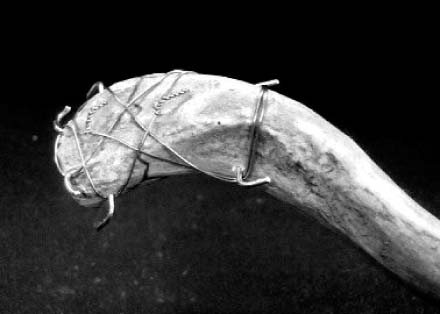J Korean Fract Soc.
2009 Jan;22(1):24-29. 10.12671/jkfs.2009.22.1.24.
Double Tension Band Wire Fixation for Unstable Fracture of the Distal Clavicle
- Affiliations
-
- 1Department of Orthopaedic Surgery, Kwangmyung Sung-Ae Hospital, Gwangmyeong, Korea. khg0623@hanmail.net
- KMID: 2183884
- DOI: http://doi.org/10.12671/jkfs.2009.22.1.24
Abstract
- PURPOSE
To evaluate the clinical results after operative treatment with the double tension band wire fixation in Neer type II and III distal clavicle fractures.
MATERIALS AND METHODS
Ten patients with type II and III distal clavicle fractures were evaluated, who operated with double tension band wire fixation technique, from Febrary 2007 to June 2008, and could be followed-up for more than 1 year after operation. Postoperative assessments were evaluated on plain x-ray, pain, and clinical finding according to the functional criteria by Kona et al.
RESULTS
Average duration from operation to fracture union was 8 weeks in all cases. There were 8 excellent and 2 good results. It was no other significant complications such as K-wire migration, breakage, infection, and AC joint arthritis.
CONCLUSION
Double tension band wire fixation technique seems to be an effective method for type II or III distal clavicle fracture with multiple compressive axis, without injury of the AC joint and loosening of the fixation.
MeSH Terms
Figure
Reference
-
1. Caspi I, Ezra E, Oliver S, Lin E, Horoszowski H. Treament of Avulsed calvicle and recurrent subluxation of the ipsilateral shoulder by dynamic fixation. J Trauma. 1987; 27:94–95.
Article2. Chun JM, Kim SY, Lee KW, Shin SJ, Kim EG. Modified tension band fixation for unstable fracture of the distal clavicle. J Korean Orthop Assoc. 2002; 37:416–420.
Article3. Craig EV. Fracture of the distal clavicle. In : Rockwood CA, Matsen FA, editors. The shoulder. Philadelphia, WB: Sauders;1990. p. 367–412.4. Edwards DJ, Kavanagh TG, Flannery MC. Fractures of the distal clavicle: a case for fixation. Injury. 1992; 23:44–46.
Article5. Flinkkilä T, Ristiniemi J, Hyvönen P, Hämäläinen M. Surgical treatment of unstable fractures of the distal clavicle: a comparative study of Kirschner wire and clavicular hook plate fixation. Acta Orthop Scand. 2002; 73:50–53.
Article6. Goldberg JA, Bruce WM, Sonnabend DH, Walsh WR. Type 2 fractures of the distal clavicle: a new surgical technique. J Shoulder Elbow Surg. 1997; 6:380–382.
Article7. Hessmann M, Kirschner R, Baumgatel F, Gehling H, Gotzen L. Treatment of unstable distal clavicular fractures with and without lesions of the acromioclavicular joint. Injury. 1996; 27:47–52.
Article8. Kang HJ, Park KK, Yoon HK, Song HK, Hahn SB. T plate fixation for unstable frature of distal clavicle. J Korean Fract Soc. 2006; 19:329–334.
Article9. Kao FC, Chao EK, Chen CH, Yu SW, Chen CY, Yen CY. Treatment of distal clavicle fracture using Kirschner wires and tension-band wires. J Trauma. 2001; 51:522–525.
Article10. Katznelson A, Nerubay J, Oliver S. Dynamic fixation of the avulsed clavicle. J Trauma. 1976; 16:841–844.
Article11. Kona J, Bosse MJ, Staeheli JW, Rosseau RL. Type II distal clavicle fracture: a retrospective review of surgical treatment. J Orthop Trauma. 1990; 4:115–120.12. Lyons FA, Rockwood CA Jr. Migration of pins used in operations on the shoulder. J Bone Joint Surg Am. 1990; 72:1262–1267.
Article13. Moneim MS, Balduini FC. Coracoid fracture as a complication of surgical treatment by coracoclavicular tape fixation. A case report. Clin Orthop Relat Res. 1982; 168:133–135.14. Neer CS II. Fracture of the distal third of the clavicle. Clin Orthop Relat Res. 1968; 58:43–50.15. Neviaser RJ. Injuries to the clavicle and acromioclavicular joint. Orthop Clin North Am. 1987; 18:433–438.
Article16. Nordqvist A, Petersson C, Redlund-Johnell I. The natural course of lateral clavicle fracture: 15(11~21) year follow-up of 110 cases. Acta Orthop Scand. 1993; 64:87–91.
Article17. Parkes JC, Deland JT. A three-part distal clavicle fracture. J Trauma. 1983; 23:437–438.
Article18. Park JH, Rha KW, Suh SW, Kim SK. Operative treatment of type 2 distal clavicle fractures. J Korean Fracture Soc. 1998; 11:683–689.19. Post M. Current concepts in the treatment of fractures of the clavicle. Clin Orthop Relat Res. 1989; 245:89–101.
Article20. Rockwood CA. Fracture of the outer clavicle in children and adults. Orthop Trans. 1982; 6:472.21. Yamaguchi H, Arakawa H, Kobayashi M. Results of the Bosworth method for unstable fractures of the distal clavicle. Int Orthop. 1998; 22:366–368.
Article
- Full Text Links
- Actions
-
Cited
- CITED
-
- Close
- Share
- Similar articles
-
- Comparison of Results of Tension Band Wire and Hook Plate in the Treatment of Unstable Fractures of the Distal Clavicle
- Modified Tenson Band Fixation for Unstable Fracture of the Distal Clavicle
- Tension Band Fixation for Type II Fracture of the Distal Clavicle
- Treatment of Distal Clavicle Type II Fracture using K-Wires and Tension Band Wiring
- Tension Band Wiring for Distal Clavicle Fracture: Radiologic Analysis and Clinical Outcome





